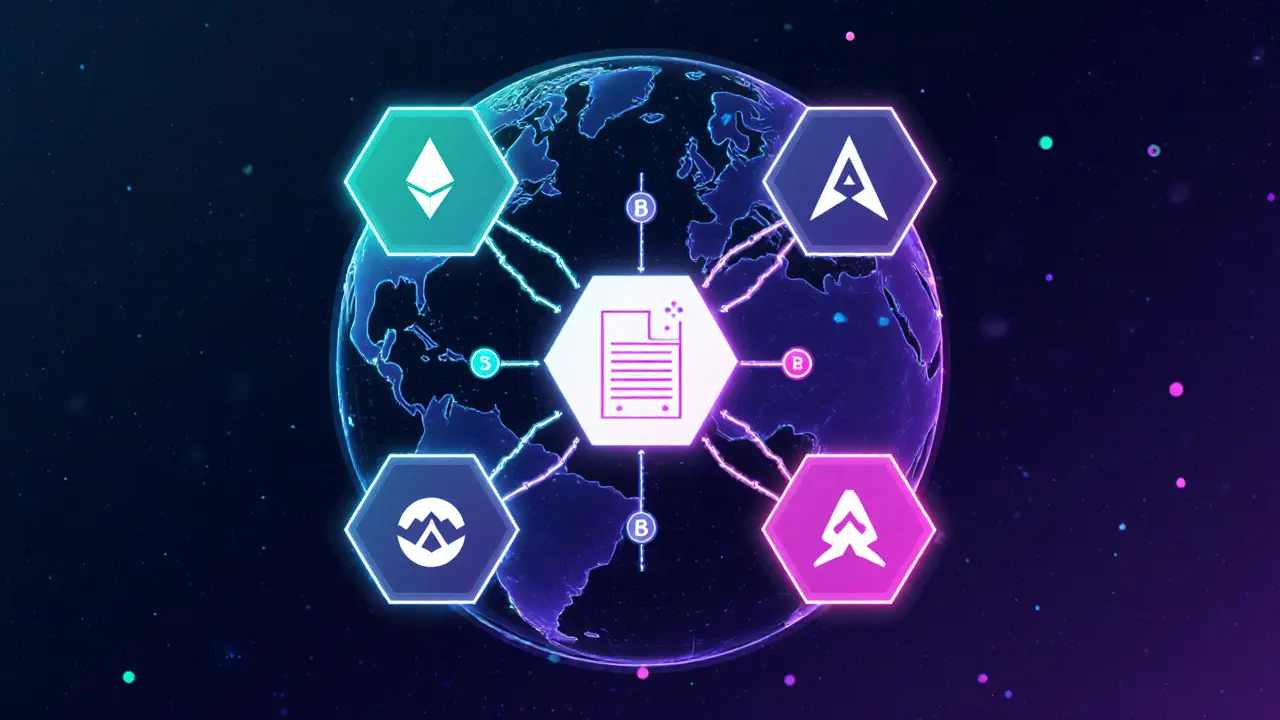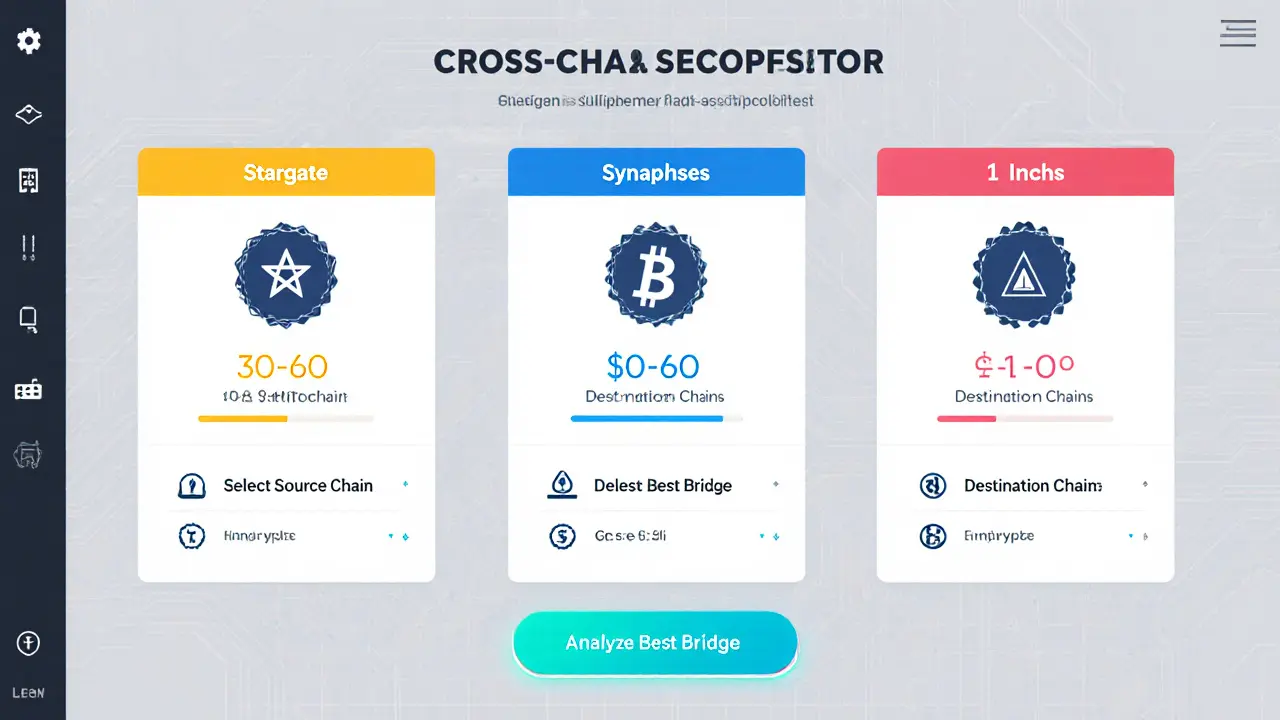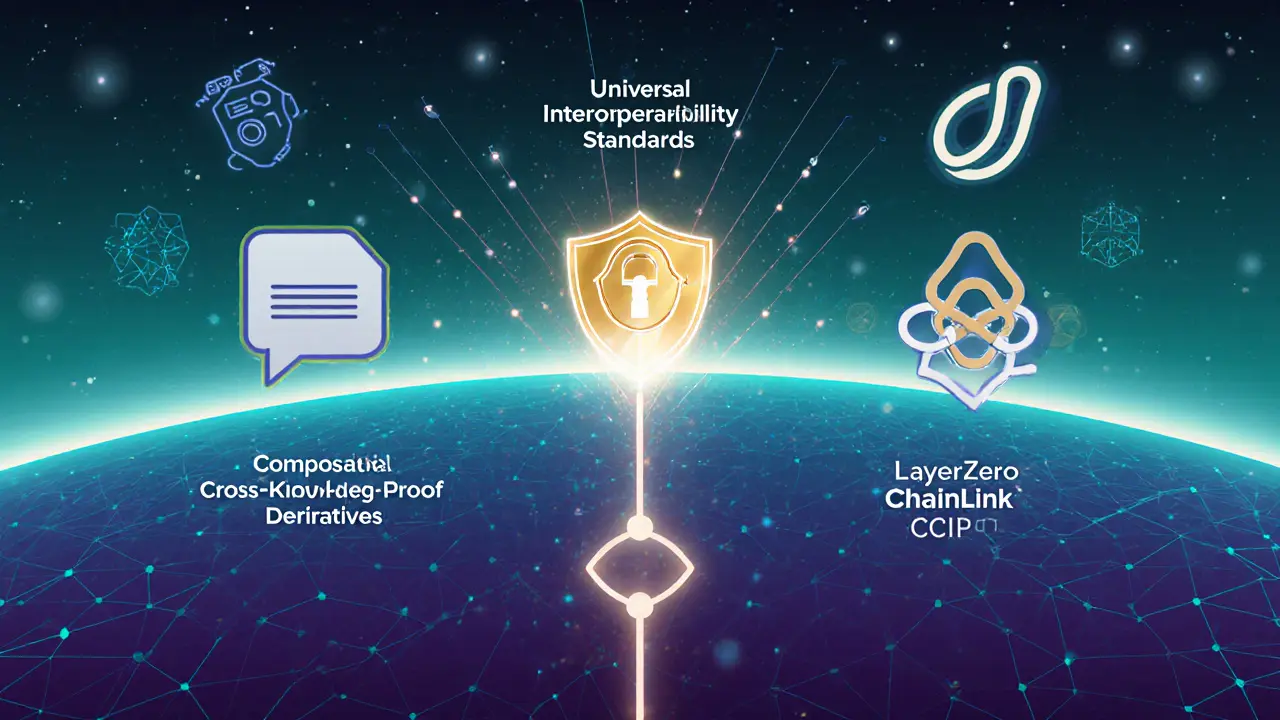Jul 25, 2025, Posted by: Ronan Caverly

Cross-Chain Bridge Comparison Tool
Compare key metrics of top cross-chain bridges to understand their trade-offs in speed, cost, and compatibility.
Stargate
Speed: 30-60 sec Fee: $0.10-$0.30
Liquidity pool + optimistic verification
Synapse
Speed: 45-90 sec Fee: $0.15-$0.40
Hybrid lock-mint + multi-sig relayers
1inch
Speed: 15-45 sec Fee: $0.05-$0.20
Smart-contract audit + real-time oracle checks
Bridge Recommendation Engine
Select source and destination chains to get personalized bridge recommendations based on speed, cost, and compatibility.
Key Takeaways
- Cross-chain DeFi connects isolated blockchains, letting users move assets and data without juggling multiple wallets.
- Core infrastructure comes from protocols like Polkadot, Cosmos, and LayerZero, while bridges such as Stargate, Synapse, and 1inch handle actual token transfers.
- Chainlink’s Cross-Chain Interoperability Protocol (CCIP) adds a trusted messaging layer that powers advanced use‑cases like synthetic assets and cross‑chain governance.
- Benefits include higher liquidity, lower fees, faster throughput, and the ability to combine unique chain features into new financial products.
- Security, audits, and robust testing remain the biggest challenges for developers building cross‑chain DeFi.
What Exactly Is a Cross-Chain DeFi Application?
When you hear the term cross-chain DeFi, think of a decentralized finance service that lives on more than one blockchain at the same time. Instead of being locked to Ethereum, Solana, or any single network, the application can read and write data across several ecosystems, moving tokens and messages in a single, frictionless flow.
Cross-Chain DeFi Applications are decentralized finance protocols that operate on multiple blockchain networks, enabling seamless asset and data exchange between them. This multi‑chain reach solves the “silo” problem that plagued early DeFi, where users had to maintain separate wallets, gas balances, and interfaces for each platform they wanted to use.
Why Interoperability Matters in 2025
The DeFi landscape now spans dozens of layer‑1s and layer‑2s, each offering its own strengths-cheap fees on Polygon, high throughput on Solana, privacy on zkSync, and composability on Ethereum. A cross‑chain approach lets a single app tap into the best of each world.
Analysts predict that by the end of 2025, over 70% of new DeFi projects will launch with built‑in cross‑chain capabilities. The shift is driven by three forces:
- Liquidity fragmentation: Users split capital across chains, leaving unused pools that could be aggregated.
- User experience: Managing multiple wallets creates friction, causing many potential users to abandon DeFi.
- Regulatory clarity: Emerging guidelines are starting to recognize cross‑chain transfers as a single financial activity, easing compliance for institutions.
Core Infrastructure That Makes It Possible
Three families of protocols form the backbone of cross‑chain DeFi:
- Polkadot is a multichain network that uses parachains and a shared relay chain to relay messages and assets securely.
- Cosmos provides the Inter‑Blockchain Communication (IBC) protocol, a standardized channel for token and data transfer between sovereign zones.
- LayerZero is an ultra‑lightweight messaging layer that connects blockchains via omnichain app contracts and off‑chain relayers.
These layers do the heavy lifting: they guarantee that a lock on Chain A corresponds to a mint on Chain B, and they secure the process with cryptographic proofs.
Bridges and Aggregators: The Hands‑On Tools
While the infrastructure does the messaging, bridges and aggregators actually move tokens. The most widely used are:
| Protocol | Supported Chains (as of Oct2025) | Typical Transfer Speed | Average Fee (USD) | Security Model |
|---|---|---|---|---|
| Stargate is a unified liquidity bridge that enables native asset transfers across multiple chains. | Ethereum, BSC, Polygon, Avalanche, Arbitrum, Optimism, Fantom | 30‑60seconds | $0.10‑$0.30 | Liquidity pool + optimistic verification |
| Synapse offers both token bridges and cross‑chain messaging for DeFi composability. | Ethereum, Solana, Polygon, Aurora, Gnosis, Celo | 45‑90seconds | $0.15‑$0.40 | Hybrid lock‑mint + multi‑sig relayers |
| 1inch integrates a DEX aggregator with cross‑chain routing capabilities. | Ethereum, BSC, Polygon, Optimism, zkSync, Base | 15‑45seconds | $0.05‑$0.20 | Smart‑contract audit + real‑time oracle checks |
These bridges differ in how they lock assets, how fast they confirm, and what extra safety nets they employ. Choosing the right one depends on the target user base, the assets involved, and the acceptable risk level.

Chainlink CCIP: The Trust Layer for Complex Use‑Cases
One of the biggest breakthroughs came from Chainlink's Cross‑Chain Interoperability Protocol (CCIP) which provides a decentralized oracle‑driven messaging framework. CCIP supports two primary modes:
- Arbitrary Messaging: Developers can send any data payload between chains, opening doors for cross‑chain NFTs, governance votes, and synthetic assets.
- Simplified Token Transfers: Audited token pool contracts handle the lock‑mint flow with built‑in rate limits and a separate Risk Management Network that monitors transaction health.
Early adopters like Synthetix use CCIP to mint synthetic assets on one chain and settle them on another, while Aave leverages CCIP for cross‑chain governance proposals, letting token holders vote from any supported network. The protocol backs its security with Chainlink’s proven oracle network, which has secured tens of billions of dollars and processed over $12trillion in transaction value to date.
Benefits: Why Developers and Users Care
Cross‑chain DeFi isn’t just a cool tech demo; it delivers concrete advantages:
- Unified Liquidity: Pools on Ethereum and Binance Smart Chain can be combined, reducing slippage for large trades.
- Fee Optimization: Users can route a transaction through a low‑fee chain (e.g., Polygon) for the cheap part, then settle on a security‑focused chain (e.g., Ethereum) for finality.
- Feature Diversity: Privacy‑preserving contracts on ZkSync can be paired with high‑speed yield farms on Solana, creating hybrid products that were impossible on a single chain.
- Scalability: By spreading load across multiple L2s, a DeFi protocol can handle spikes without congesting any single network.
From an institutional perspective, cross‑chain capability also means better capital efficiency. A hedge fund can allocate assets across chains in real‑time, automatically rebalancing based on market conditions without manual transfers.
Security Considerations: The Double‑Edged Sword
More moving parts mean more attack surfaces. The main risks include:
- Bridge exploits: Historical bridge hacks have shown that a single buggy contract can compromise millions of dollars.
- Message tampering: If a relayer is compromised, arbitrary messaging could be altered, leading to faulty state changes.
- Cross‑chain replay attacks: Improper nonce handling can allow an attacker to replay a transaction on another chain.
Best practices for developers:
- Run formal verification on bridge contracts and use multiple, independent auditors.
- Implement time‑locked upgrades and multi‑sig governance for critical components.
- Leverage proven oracle networks like Chainlink for message validation.
- Monitor on‑chain telemetry with tools that flag abnormal transfer patterns.
Development Workflow: From Idea to Live Cross‑Chain Product
A typical cross‑chain DeFi project follows these stages:
- Protocol Selection: Choose the underlying interoperability layer (Polkadot, Cosmos, LayerZero) based on target chains and required throughput.
- Bridge Design: Define how assets will be locked and minted. Decide whether to use an existing bridge (Stargate, Synapse) or build a custom contract.
- Smart‑Contract Development: Write on‑chain logic for each supported chain, ensuring identical state transitions.
- Message Relay Integration: Connect to relayers or oracle networks that will carry data between chains.
- Testing & Simulation: Run end‑to‑end tests on testnets for every chain pair, using fuzzing tools to catch edge cases.
- Audit & Bug‑Bounty: Conduct third‑party security audits and launch a public bounty for residual bugs.
- Launch & Monitoring: Deploy on mainnets, enable health‑checks, and set up alerts for abnormal transfer volumes.
Because each chain has its own tooling (e.g., Solidity on Ethereum, Rust on Solana), developers often build a unified SDK that abstracts away chain‑specific quirks, letting front‑end engineers focus on the user experience.
Market Trends and Outlook for 2025‑2026
Data from DeFi analytics firms show that cross‑chain transaction volume surged from $3billion in early 2024 to over $12billion by mid‑2025. The growth is driven by three emerging patterns:
- AI‑Native DeFi: Machine‑learning bots now execute arbitrage across chains in milliseconds, requiring real‑time cross‑chain messaging.
- TradFi Partnerships: Banks and asset managers are piloting hybrid products that lock fiat‑backed stablecoins on a private ledger while providing DeFi yield on Ethereum via a cross‑chain bridge.
- Regulatory Alignment: Several jurisdictions have released guidance that treats cross‑chain transfers as internal movements, lowering compliance costs for institutional players.
Looking ahead, we expect standards like the Interchain Security Module (ISM) for Polkadot and the upcoming Cosmos SDK v2 to tighten security, while user‑friendly wallets will integrate one‑click cross‑chain swaps, effectively making the underlying complexity invisible to end users.
Future Directions: What’s Next for Cross‑Chain DeFi?
Three areas will shape the next wave of innovation:
- Universal Interoperability Standards: Projects are converging on a common message format, which will let any DApp plug into any bridge without custom adapters.
- Zero‑Trust Bridges: Leveraging zero‑knowledge proofs to verify transfers without exposing underlying transaction data, boosting privacy.
- Composable Cross‑Chain Derivatives: Platforms are already testing options and futures that settle on multiple chains, enabling sophisticated hedging strategies.
When these pieces fall into place, DeFi will finally achieve the “single financial layer” vision that early blockchain pioneers dreamed of-a layer where assets, data, and contracts coexist across a global network of blockchains, all accessible with a single click.

Frequently Asked Questions
How does a cross‑chain bridge actually move tokens?
Most bridges work by locking the original token in a smart contract on the source chain, then minting a wrapped version on the destination chain. When the user wants to move back, the wrapped token is burned and the original token is released. Security relies on cryptographic proofs that the lock event occurred before the mint.
Is it safe to use multiple bridges in a single transaction?
Using multiple bridges increases complexity and risk. Always stick to audited bridges, check their recent audit reports, and consider using a single‑hop solution (e.g., Ethereum → Polygon via Stargate) rather than chaining several hops.
What are the main advantages of Chainlink CCIP over traditional bridges?
CCIP adds a decentralized oracle layer that validates messages and transfers, provides built‑in rate limiting, and includes a dedicated risk‑management network. This reduces reliance on a single bridge operator and offers stronger guarantees against fraud.
Can cross‑chain DeFi be used with fiat‑backed stablecoins?
Yes. Stablecoins like USDC or USDT exist on most major chains. A cross‑chain DApp can lock USDC on Ethereum, mint a wrapped version on Solana, and let users earn yield on the Solana side, all while the underlying fiat backing remains unchanged.
What should developers watch out for when testing cross‑chain logic?
Test every chain pair on its respective testnet, simulate network latency, and use fuzzing tools to generate unexpected inputs. Validate that state on one chain matches the expected state on the other after every simulated transfer.
Write a comment
Comments
Jerry Cassandro
Cross‑chain DeFi relies on a series of coordinated steps that must be executed flawlessly to protect user funds. First, a smart contract on the source chain locks the original asset, emitting a verifiable event that can be observed by off‑chain relayers. Next, relayers submit cryptographic proofs to the destination chain, confirming that the lock actually occurred. Once verified, a mint or release contract creates a wrapped representation of the asset on the target network. Throughout this process, each bridge should undergo formal verification to eliminate subtle bugs. Audits by multiple independent firms add another layer of confidence. Time‑locked upgrade mechanisms ensure that any future changes can be reviewed by the community before activation. Multi‑signature governance reduces the risk of a single key compromise. Monitoring tools should track abnormal transfer volumes in real time, flagging spikes that could indicate an exploit. Developers should also simulate network latency on testnets to mimic real‑world conditions. Using standardized message formats, such as those being proposed by the Interchain Security Module, eases integration across multiple bridges. Incorporating zero‑knowledge proofs can further enhance privacy while maintaining trustlessness. It's advisable to combine a liquidity‑rich bridge like Stargate with a safety‑oriented solution such as LayerZero for critical assets. Users should diversify by not routing all capital through a single bridge, spreading risk across several providers. Finally, keep an eye on emerging standards like Cosmos SDK v2, which aim to harden security guarantees across the ecosystem.
July 25, 2025 AT 22:30
Parker DeWitt
Honestly, most of these “innovations” are just marketing fluff, and the hype is ridiculous 😤. If you want real security, stick with tried‑and‑true L1s instead of hopping around like a tourist. The only bridge worth your time is the one that doesn't expose your assets to foreign code.
July 26, 2025 AT 04:03
Allie Smith
Wow, this whole cross‑chain thing feels like the future of finance, super exciting! I love how you can move assets without juggling a bunch of wallets, it's sooo convenient. Even if there are bumps, the community will figure it out together. Keep pushing the boundaries, DeFi fam!
July 26, 2025 AT 09:37
Lexie Ludens
I feel the weight of every shaky bridge like an ominous cloud looming over our wallets. The drama of hacks is enough to make my heart race, and the endless audits seem like a futile prayer. Yet we're still chasing that elusive promise of seamless swaps, as if nothing could possibly go wrong.
July 26, 2025 AT 15:10
Aaron Casey
From an architectural standpoint, leveraging a hybrid lock‑mint model with multi‑sig relayers reduces the attack surface, especially when coupled with LayerZero's omnichain app contracts. The interoperability stack should incorporate CCIP’s rate limiting and risk‑management network to mitigate replay vectors. Moreover, integrating IBC channels alongside Polkadot’s XCMP can provide deterministic finality across heterogeneous zones.
July 26, 2025 AT 20:43
Leah Whitney
Great overview! If you're building a cross‑chain product, start by mapping out the user flow end‑to‑end, then pick a bridge that aligns with your latency tolerance. Test each chain pair on its respective testnet before hitting mainnet, and don’t forget to run fuzzing on the lock‑mint logic. This disciplined approach will save you headaches later.
July 27, 2025 AT 02:17
Lisa Stark
In many ways, cross‑chain DeFi mirrors the philosophical quest for unity amidst diversity. Each blockchain holds its own logic, yet through bridges we achieve a higher-order synthesis. The challenge lies not only in technical execution but in trusting the underlying consensus of disparate communities.
July 27, 2025 AT 07:50
Logan Cates
Everyone talks about “security audits” like they’re the silver bullet, but who’s really watching the auditors? I suspect hidden backdoors in some of these bridge contracts, waiting for an insider to pull the trigger. Stay vigilant and never trust a bridge that isn’t open‑source.
July 27, 2025 AT 13:23
Shelley Arenson
Sounds like a solid roadmap for interoperable finance! 😊
July 27, 2025 AT 18:57
Joel Poncz
Thanks for breaking it down, I really appreciate the clear steps. It's nice to see the community focusing on both speed and safety. Keep up the good work!
July 28, 2025 AT 00:30
Kris Roberts
I've been following the cross‑chain space for a while, and it's fascinating to see how quickly the tooling matures. The real test will be whether users adopt these bridges without fear from past hacks.
July 28, 2025 AT 06:03
lalit g
It's encouraging to see developers from different ecosystems collaborating on standards. By aligning on common protocols, we can reduce fragmentation and build a more inclusive financial layer for everyone.
July 28, 2025 AT 11:37
Reid Priddy
Another “breakthrough” announcement, yet we keep seeing the same pattern of overpromised features and underdelivered security. Until bridges can guarantee zero loss, skepticism remains justified.
July 28, 2025 AT 17:10
Shamalama Dee
When guiding newcomers, emphasize the importance of auditing each bridge’s code and understanding the underlying liquidity model. Encourage them to start with small test transactions to verify behavior before scaling up.
July 28, 2025 AT 22:43
scott bell
Jumping into cross‑chain DeFi is like stepping onto a new frontier the risks are high but the rewards even higher keep learning stay bold and you’ll shape the future

Author
Ronan Caverly
I'm a blockchain analyst and market strategist bridging crypto and equities. I research protocols, decode tokenomics, and track exchange flows to spot risk and opportunity. I invest privately and advise fintech teams on go-to-market and compliance-aware growth. I also publish weekly insights to help retail and funds navigate digital asset cycles.